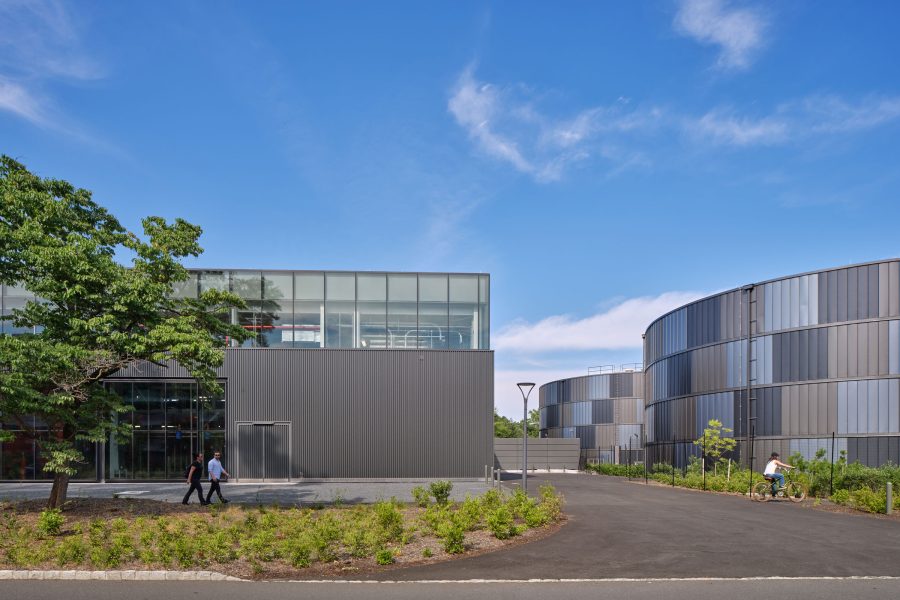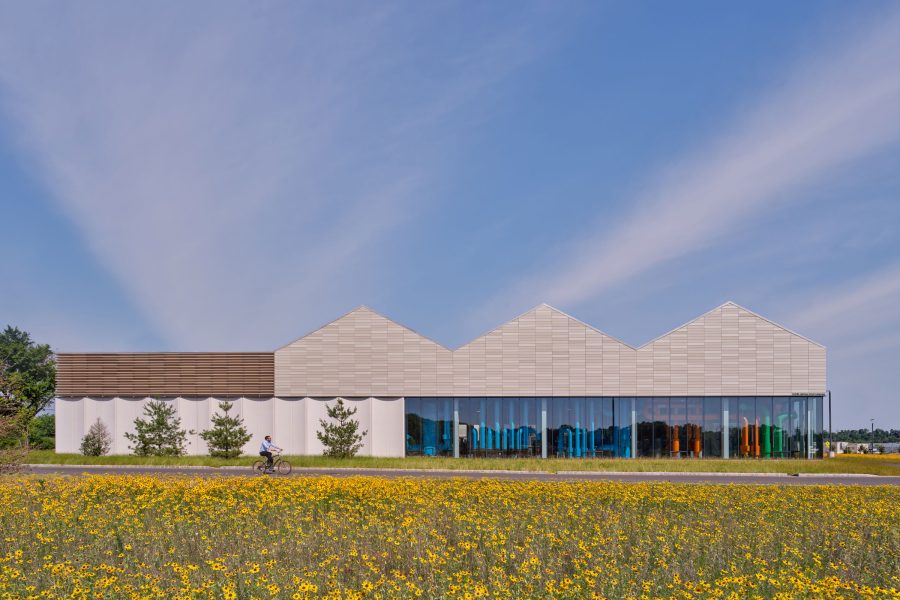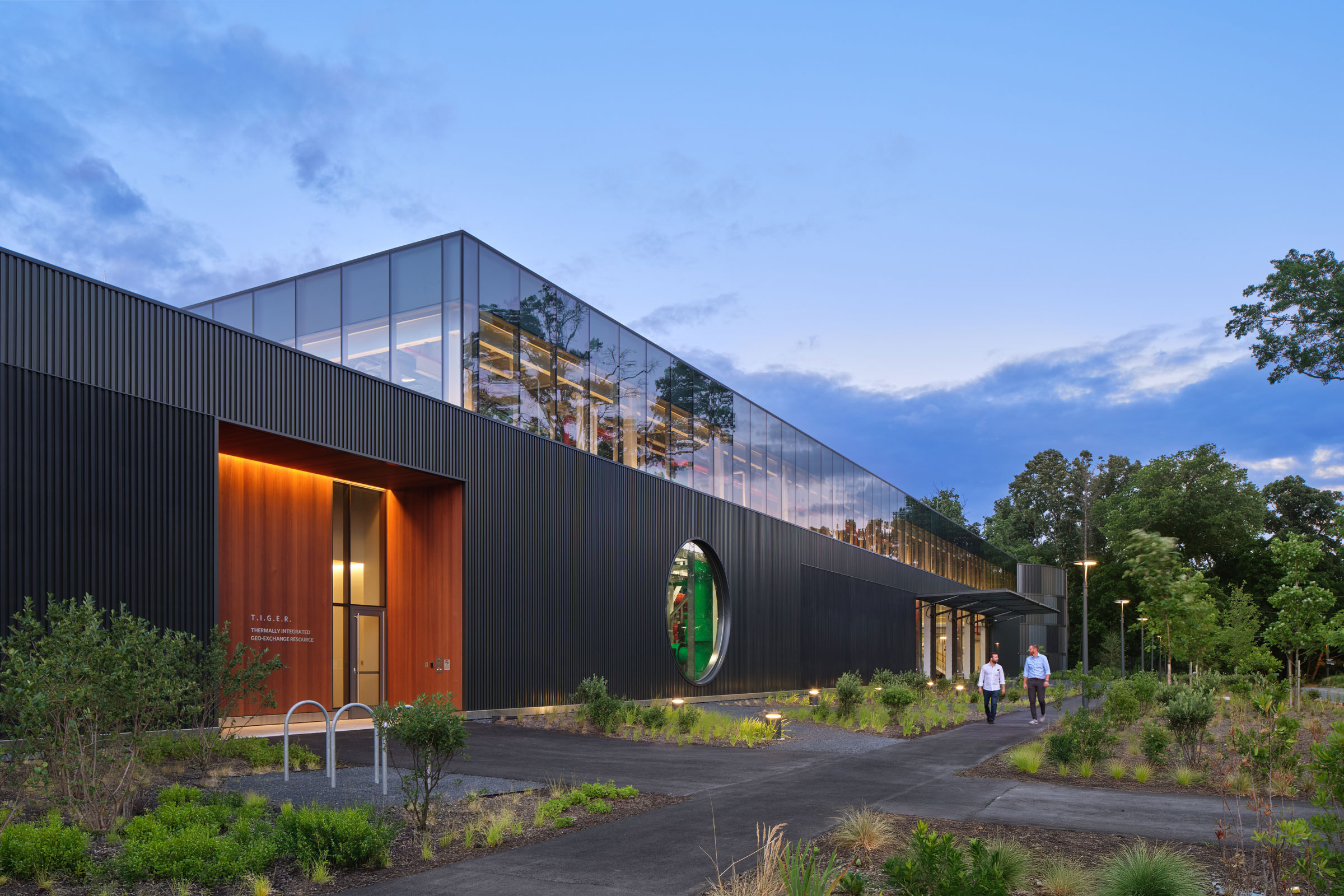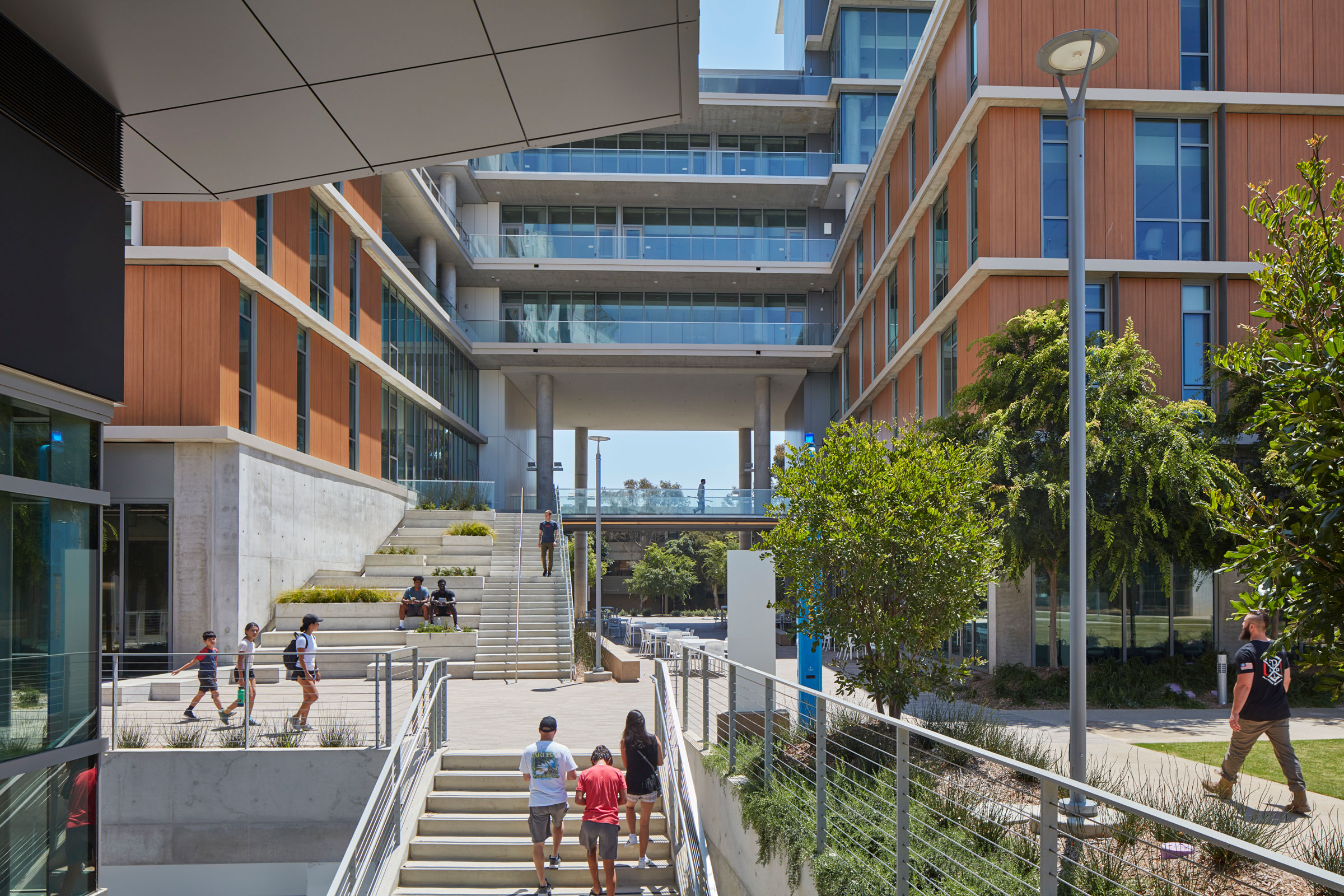Story at a glance:
- Princeton University is pioneering a geo-exchange energy system as part of its plan to go net zero by 2046.
- The buildings that house the new system—TIGER and CUB—are the antithesis of typical energy infrastructure.
- ZGF Architects made TIGER and CUB feel inviting with strategically placed windows, colorful accents, and playful design touches.
Amidst Princeton University’s centuries-old campus, a new building covered in oversized glass and metal is bound to attract attention.
When passersby peek inside, they won’t find a student center, a library, or a classroom. They’ll see a maze of colorful pipes that are catapulting the campus into a lower-carbon future.
A New Type of Utility Building

ZGF completed the Princeton project—a suite of two geo-exchange central energy buildings, a parking garage, and a transit hub—in late 2023. Photo by Halkin Mason Photography
Most utility plants are foreboding industrial buildings hidden from public view. That couldn’t be further from what the architects at ZGF created for Princeton’s new geo-exchange system.
ZGF broke ground on the Princeton Project—a suite of two geo-exchange central energy buildings, a parking garage, and a transit hub—in 2019. The new facilities, which officially opened to the public last year, help facilitate Princeton’s goal to achieve net-zero emissions by its 300th anniversary in 2046.
Geo-exchange systems essentially “use the earth as a thermal piggy bank,” Maryam Katouzian, a ZGF architect and the principal in charge of the Princeton project, says.
Installing one at Princeton involved drilling more than 1,000 boreholes up to 850 feet (nearly three football fields) deep into the ground on sites across campus. University buildings connect to these bore fields through a network of underground pipes.
In the summer heat is extracted from buildings and used to heat water that is then stored underground in this closed-loop system. Come winter, stored heat is delivered back into buildings. At the same time cold air is harnessed and stored to eventually cool buildings on hot days.
Princeton helped us think outside of the box because of the mission and the goals they had for the project.
Geo-exchange systems require a lot of land and money to build (part of the reason they’re not more common in the US), but their potential to reduce emissions is impressive. Princeton estimates that its new system is five times more efficient than its old gas-powered steam heating and cooling system.
“Princeton helped us think outside of the box because of the mission and the goals they had for the project,” Katouzian says with genuine enthusiasm. “They have really taken it upon themselves to be a pioneer and set an example for their peer institutions.”
Facilitating the flow of hot and cold water through a maze of laboratories, residential buildings, classrooms, and computer facilities, each with its own temperature requirements, is complicated work.
ZGF was challenged with turning the “guts” of this complex new geo-exchange system—a labyrinth of pipework, heat pumps, water storage tanks, and electrical equipment—into something worth looking at.
Layered Design

Onsite water storage tanks are roughly the same height as the neighboring TIGER building. Photo by Halkin Mason Photography
ZGF was tasked with making Princeton’s two central energy buildings, fittingly named TIGER and CUB after the school mascot, equal parts beautiful and functional.
One way they accomplished this was using a generous amount of glass to reveal the building’s colorful interior pipes (red, blue, and green based on their water’s temperature and destination). “We were very strategic about opening up the facade and revealing specific moments of the building,” Katouzian says.
ZGF also played around with scale to make the design more approachable. Both TIGER and CUB sit next to two water storage tanks that are around 80 feet in diameter. “We had to be very careful around designing the storage tanks so they weren’t just these giant concrete structures,” Katouzian says.
After multiple rounds of back and forth with different vendors and engineers, they opted to bury 20 feet of these tanks underground and cover them in the same sleek metal as the TIGER building. This helped them better blend in with the overall site design.
This decision also fits into Princeton’s emphasis on multi-layered sustainable construction. Buildings around campus might have bore holes underneath them and solar panels on top of them, for example. “They’re stacking buildings with opportunities to get them to their goal for carbon neutrality,” Katouzian says.
Rewarding Curiosity
Princeton’s geo-exchange facilities are open to student tours, serving as teaching tools for sustainable energy production. ZGF used subtle visual cues to show how approaching TIGER and CUB is not only safe but encouraged.
The circular window in front of the TIGER building is one such thoughtful touch. “We wanted to create this moment of, ‘Oh, what’s going on here?,’” Katouzian says. The shape sticks out against the otherwise streamlined building, evoking curiosity about what’s on the other side of the glass.
The nearby building entrance is covered in western red cedar paneling. The warm wood pops against the otherwise metallic exterior, extending a hand out to visitors.
ZGF also worked with other collaborators to make the entire site feel more cohesive and welcoming. “We worked directly with our landscape architect to create these meandering paths that would help people to find their way to those glazed areas and peek through, letting their curiosity lead them,” Katouzian says.
Past Meets Future

CUB’s gabled roof feels fitting to its more rural surroundings. “It’s very pastoral,” says Maryam Katouzian, a ZGF architect and the principal in charge of the Princeton project, of the building. Photo by Halkin Mason Photography
While TIGER is in the heart of Princeton’s main campus, CUB is in a relatively undeveloped area that’s adjacent to a state park. In the future the goal is to make this Meadows Neighborhood a hub for recreation facilities and graduate housing while still maintaining its bucolic feel. “We wanted to remain true to the context we were sitting in,” Katouzian says of CUB, so her team opted to cover the building in an old-fashioned gabled roof.
As Princeton nears its tricentennial the university hopes its new geo-exchange system will last for at least the next 100 years. As such ZGF designed TIGER and CUB to be flexible, with plenty of extra space for equipment to be added as new buildings join the network. All told they will provide heating and cooling for 180 on-campus buildings.
Since the Princeton Project wrapped up last year multiple universities have reached out to ZGF to learn more about its design and energy infrastructure. Katouzian sees this as a sign that the project is successfully telling the story of the renewable technology that fuels it.



